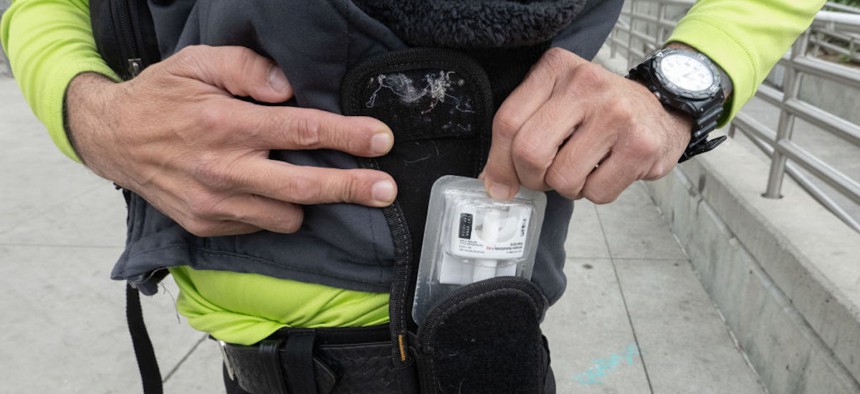How state and local agencies are working together to quell the opioid crisis

Fabian Bolanos, a Metro Ambassador, is equipped with Narcan, for opioid overdoses as well as a CPR resuscitator mask kit. He works at the Metro Westlake / MacArthur Park station and has revived people with drug overdoses in L.A. County. Photographed on Wednesday, June 7, 2023. Myung J. Chun / Los Angeles Times via Getty Images
Leaders at every level of government underlined the importance of collaboration to effectively leverage funding to address the nationwide opioid epidemic during a recent National Association of Counties event.
Nationwide opioid-related overdose deaths have seemingly stabilized, following a treacherous rise during the pandemic, a federal health official says. But the fight against the opioid crisis is far from over for local leaders.
Indeed, the recent buzz of the holiday season was paired with overdose spikes in some communities like Lexington, Kentucky, and Portland, Maine. And despite overall overdoses in the U.S. slowing down since 2021, 31 states saw fentanyl-related deaths increase in 2023.
The opioid crisis “is not a red state or blue state issue,” said Dr. Rahul Gupta, director of the federal Office of National Drug Control Policy during a Jan. 10 webinar hosted by the National Association of Counties. “This is America’s issue. It’s a family issue.”
Gupta compared reversing the deadly opioid crisis to changing the direction of an ocean liner: “You can’t just turn it around…. You’ve got to slow it down, put it to a stop [and] turn it around.”
But curbing the opioid addiction crisis can’t be done by one person, one department or one government. A collaborative whole-of-government approach is needed within and across the U.S. to effectively allocate lifesaving treatment and prevention resources to individuals in need, Gupta said.
For local leaders, that means it’s not just county health departments or law enforcement agencies that should be prepared to respond to an overdose crisis, said Matt Chase, the CEO and executive director at the National Association of Counties. Employees at schools, libraries and recreation centers, for instance, should also be ready to administer a dose of naloxone, especially considering local and county responders are often the first line of defense against an overdose or substance use disorder.
But before local leaders can pour harm reduction and prevention resources into their communities, Gupta said counties must first identify where they can get money to combat the opioid crisis.
County officials should be aware of available funds from sources like the federal Health and Human Services Department, the Centers for Disease Control and Prevention and state opioid response grants, he said. They should also keep track of each program’s purposes and restrictions so funds can be maximized even if they’re limited.
“The secret here is awareness. It's important for county-level elected officials to be aware of what dollars are eligible from the federal government for the state, what is coming down and the differential between the two,” Gupta said.
That way, county officials can ensure that state-administered funds are maximized to their fullest extent, as observers have criticized states’ slow distribution of opioid settlement funds, for instance, while residents continue dying from overdoses.
Local governments should also pay close attention to how money from the national opioid settlement is doled out by federal and state governments.
On the East coast, Virginia established the Opioid Abatement Authority in 2021 to distribute settlement funds to state, county and city agencies. The independent agency is responsible for allocating 55% of the state’s slice of settlement money. Of that amount, 15% is reserved for cities and counties and 35% is meant for cooperative projects involving multiple cities and counties, according to the authority’s site. State agencies get 15% and the rest of that share controlled by the Abatement Authority (35%) is unrestricted.
The authority also created a “gold standard” for spending settlement money, said Anthony E. “Tony” McDowell, executive director of the Virginia Opioid Abatement Authority. Under the standard, if cities and counties report that they’ve allocated 100% of their settlement funds on approved opioid crisis abatement and remediation, the agency will increase the amount they’re eligible to receive by 25%.
On the West coast, however, one state is still working out the kinks of intergovernmental collaboration. Oregon counties have spent “a decade of not working very closely with the state,” said Gina Firman Nikkel, executive director of the Association of Oregon Counties. “What I will say is: We’re changing that right now.”
Oregon is poised to receive about $325 million over the next 18 years from settlement funds, which inspired the creation of the state’s Opioid Settlement Prevention, Treatment and Recovery Board in March 2022. Nikkel said board members have been meeting since November 2022 to develop a spending plan for administering funds to counties and localities.
The 2022 bill authorizing the board requires that funds be administered to evidence-based programs aimed at treating or preventing substance use disorders, including programs and services that address concurrent issues such as mental health conditions or being at-risk for incarceration.
It also requires an unspecified portion of funds be spent on “a unified and evidence-based state system for collecting, analyzing and publishing data about the availability and efficacy of substance use prevention, treatment and recovery services statewide.”
“A strong intergovernmental partnership is crucial to addressing our nation’s ongoing opioid crisis,” Nikkel said. “Federal, state and local officials must work hand in hand to achieve our shared goal of ensuring those that are in need in our communities receive the most critical care that they deserve.”






